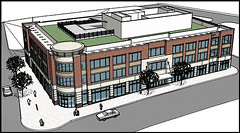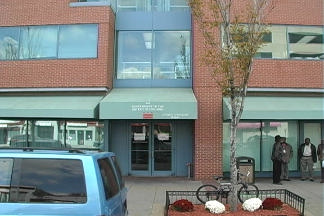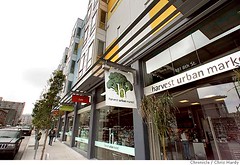Falling up -- Accountability and DC Community Development Corporations
Today's Post has a column titled "Subway Fracas Escalates Into Test Of the Internet's Power to Shame" about how in Korea, a woman was shamed via the Internet after refusing to clean up after her dog on the subway. In the U.S., I don't think something like this could happen, because we don't have much of a culture of responsibility. Plus, the digital divide would make it hard to shame people who aren't online.
In May, at their awards dinner, the DC Building Industry Association gave awards to the Anacostia Economic Development Corporation, the H Street Community Development Corporatation, the Development Corporation of Columbia Heights, and the Marshall Heights Community Development Organization.
Three of these four organizations have been the subject of numerous articles about self-dealing, mis-use of resources, or other practices that ought to call into question their continued feeding at the public trough.
The Post has run many articles about these organizations over the years, including full-page stories after the jump detailing abuse (and success by the MHCDO).
These are but a few of the articles, which are accessible online (for a fee):
- Federal Money Flowed With Little Oversight: City Promises to Cut Off Ineffectual Groups
Carol D. Leonnig; The Washington Post; Feb 24, 2002; pg. A.13
- D.C. Revitalization Promised, Not Delivered: Nonprofits Collect Millions as Work Goes Undone, Neighborhoods Left With Eyesores
Carol D. Leonnig Marcia Slacum Greene and Yolanda Woodlee; The Washington Post; Feb 24, 2002; pg. A.01
- Risky Ventures, Little Accountability: After Years of Public Funding, Nonprofits Have Completed Few Projects
Marcia Slacum Greene Yolanda Woodlee and Carol D. Leonnig; The Washington Post; Feb 25, 2002; pg. A.01
-Blighted Sites May Revert To D.C.: Revival Has Stalled Under Nonprofits
Carol D. Leonnig and Yolanda Woodlee; The Washington Post; Feb 26, 2002; pg. B.01
-$100 Million Down the Drain [Editorial]
The Washington Post. Washington, D.C.: Feb 28, 2002. pg. A.22
- D.C. Housing Authority Fines Nonprofit: Development Group Sold Two Row Houses, Meant for Individuals, to Investor
Carol D. Leonnig; The Washington Post; May 3, 2002; pg. B.05
And yet these organizations win awards from the traditional builders and developers in the city, and continued funding from sources managed by the DC Government.
You'd think that the power of the press, with the distribution of 700,000+ copies/day of this newspaper, that there would be some repercussions. Where is the World Wide Web when you need it?
Today's Post also has an article, "Rising Anacostia Project Seen as Catalyst: Development Will Follow, Officials Say" about a new building to be constructed in Anacostia. From the article: "The first large commercial construction project in Anacostia in 15 years will, according to D.C. officials, spark a long-overdue surge of development in one of the city's poorest sectors. Some civic leaders in the neighborhood are concerned about how the $19 million Anacostia Gateway project will affect traffic, property taxes and rents for small-business owners, but others in the retail-store-starved community are cautiously optimistic. (...)
Anacostia Gateway LLC, which is undertaking the venture, includes the Anacostia Economic Development Corp., DRI Partners and the National Capital Revitalization Corp. The city sold the land at a discounted price as an incentive, Hopkins said. The Gateway project has been long in the planning. The D.C. Department of Housing and Community Development and the Anacostia Economic Development Corp. have bought 16 parcels there over 11 years, Hopkins said. The lots mainly contained vacant structures, but a few housed small businesses, he said.
 Anacostia Gateway Project. The AEDC wins again.
Anacostia Gateway Project. The AEDC wins again.BTW, the talk in the article is about how this project will be a great catalyst, but revitalization is a lot more nuanced. At 49,000 square feet of office space, this building will house either 245 workers (at 200 sq. ft. of space for each worker) or 196 workers (at 250 sq. ft. per worker).
According to Robert Gibbs, one of the nation's leading retail consultants, the average office worker supports annually two (2) square feet of retail space and five (5) square feet of restaurant space.
I'll let you figure out the numbers yourselves. It can't be much of a catalyst for retail development.
This is what happened on H Street with the construction of two office buildings on the south side of the 600 block. I joke that the spillover economic development has been the two hot dog vendors that hadn't been present on the corridor previously.
 DC Dept. of Health office on H Street N.E., Washington, DC.
DC Dept. of Health office on H Street N.E., Washington, DC. It is for this reason that I haven't favored the DC government's proposed "neighborhood" revitalization strategy of deconcentrating government services and relocating them around the city (i.e., DMV up on Georgia Avenue, which had been proposed, or the relocation of DOES to the Minnesota Avenue Metro Station).
_______
Constrast these projects to one in San Francisco, in this article by John King, "A SOMA complex with a coffee shop and lively mural proves that affordable housing doesn't have to be ugly housing." This mixed-use affordable housing complex has a grocery store and a cafe on the ground floor--on the street. (Note: I still think they could open up to the street better. The grocery store that failed on H Street, part of the complex of buildings constructed by the H Street CDC, was perpendicular to the street, and this likely contributed to its lack of success.) Also see this story about the Harvest Urban Market, and this page from the architect's website about the SOMA project (great photos).
 The housing complex at Eighth and Howard streets is home to 88 small apartments -- and the Harvest Urban Market. San Francisco Chronicle photo by Chris Hardy.
The housing complex at Eighth and Howard streets is home to 88 small apartments -- and the Harvest Urban Market. San Francisco Chronicle photo by Chris Hardy.Why is it so difficult for DC-based community development corporations to bring such mixed-use, somewhat creative projects to fruition?
For another creative cdc-based project in the SF Bay area, check out this case study of the Fruitvale Transit-Oriented Development project in Oakland, California, which involved the local LISC, and CDC, which created a Main Street program to initiate commercial district revitalization in their neighborhood.



0 Comments:
Post a Comment
<< Home